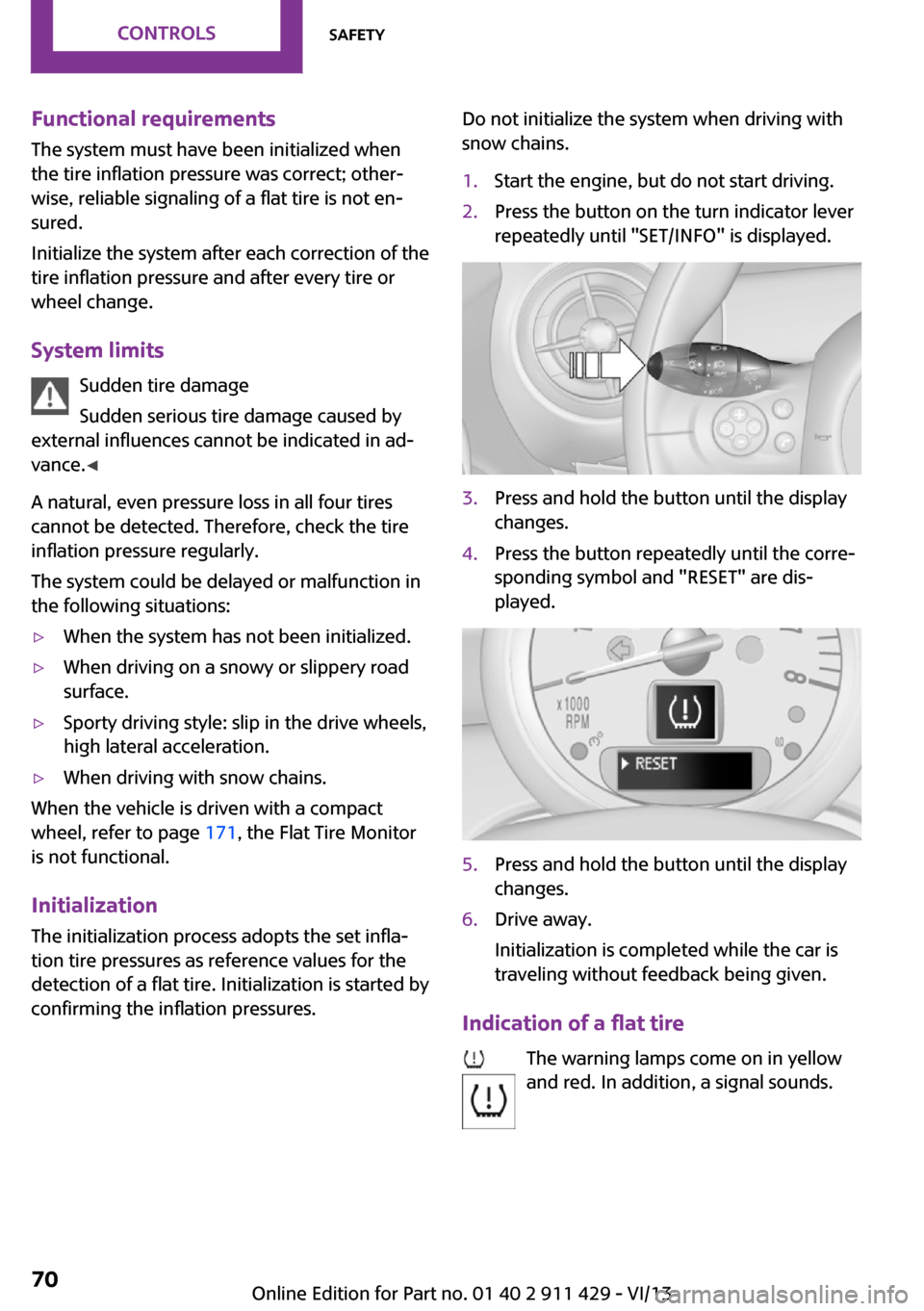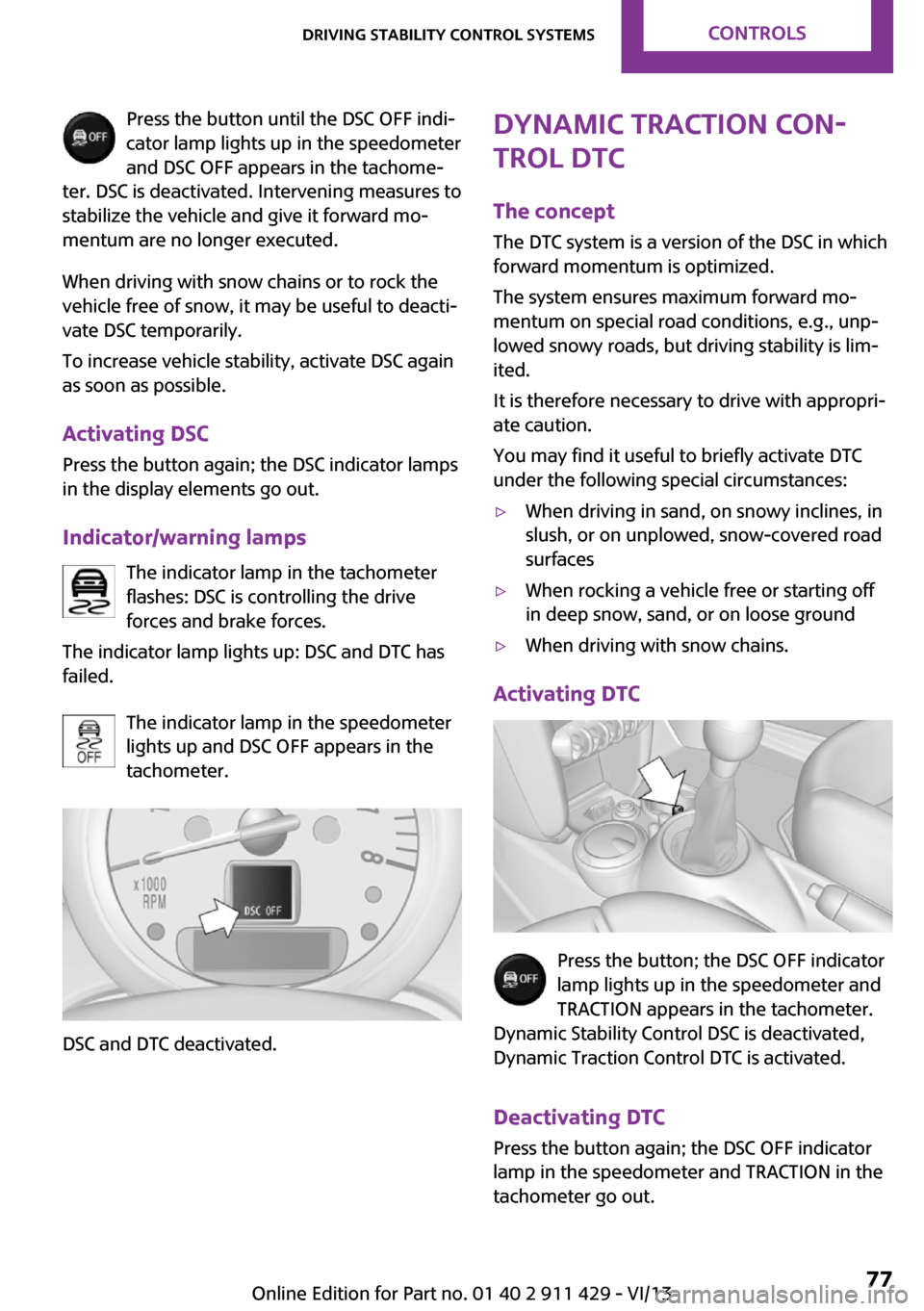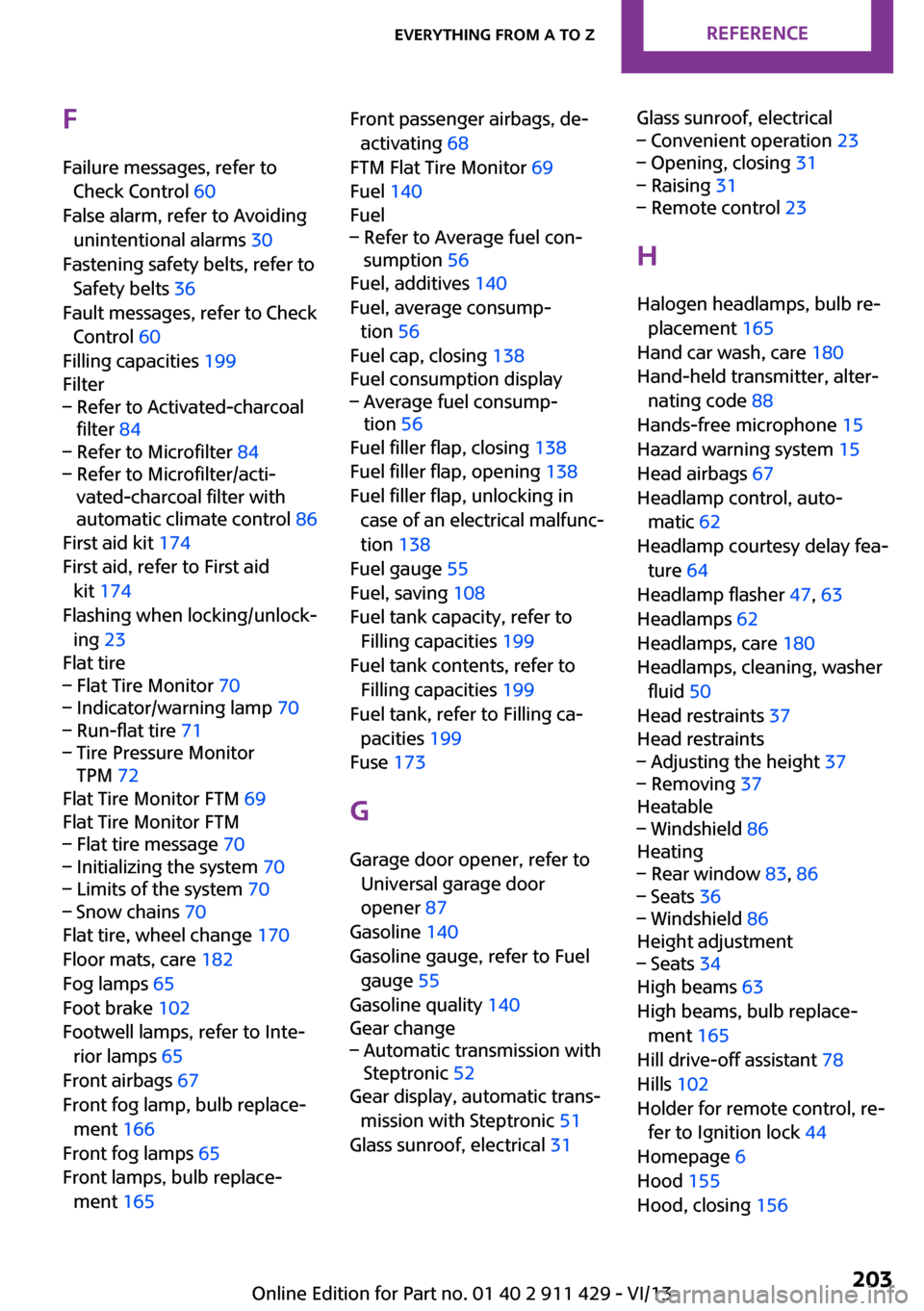snow chains MINI Clubman 2014 Owner's Manual
[x] Cancel search | Manufacturer: MINI, Model Year: 2014, Model line: Clubman, Model: MINI Clubman 2014Pages: 210, PDF Size: 5.12 MB
Page 70 of 210

Functional requirementsThe system must have been initialized when
the tire inflation pressure was correct; other‐
wise, reliable signaling of a flat tire is not en‐
sured.
Initialize the system after each correction of the
tire inflation pressure and after every tire or
wheel change.
System limits Sudden tire damage
Sudden serious tire damage caused by
external influences cannot be indicated in ad‐
vance. ◀
A natural, even pressure loss in all four tires
cannot be detected. Therefore, check the tire
inflation pressure regularly.
The system could be delayed or malfunction in
the following situations:▷When the system has not been initialized.▷When driving on a snowy or slippery road
surface.▷Sporty driving style: slip in the drive wheels,
high lateral acceleration.▷When driving with snow chains.
When the vehicle is driven with a compact
wheel, refer to page 171, the Flat Tire Monitor
is not functional.
InitializationThe initialization process adopts the set infla‐
tion tire pressures as reference values for the
detection of a flat tire. Initialization is started by
confirming the inflation pressures.
Do not initialize the system when driving with
snow chains.1.Start the engine, but do not start driving.2.Press the button on the turn indicator lever
repeatedly until "SET/INFO" is displayed.3.Press and hold the button until the display
changes.4.Press the button repeatedly until the corre‐
sponding symbol and "RESET" are dis‐
played.5.Press and hold the button until the display
changes.6.Drive away.
Initialization is completed while the car is
traveling without feedback being given.
Indication of a flat tire
The warning lamps come on in yellow
and red. In addition, a signal sounds.
Seite 70ControlsSafety70
Online Edition for Part no. 01 40 2 911 429 - VI/13
Page 77 of 210

Press the button until the DSC OFF indi‐
cator lamp lights up in the speedometer
and DSC OFF appears in the tachome‐
ter. DSC is deactivated. Intervening measures to
stabilize the vehicle and give it forward mo‐
mentum are no longer executed.
When driving with snow chains or to rock the
vehicle free of snow, it may be useful to deacti‐
vate DSC temporarily.
To increase vehicle stability, activate DSC again
as soon as possible.
Activating DSC
Press the button again; the DSC indicator lamps
in the display elements go out.
Indicator/warning lamps The indicator lamp in the tachometer
flashes: DSC is controlling the drive
forces and brake forces.
The indicator lamp lights up: DSC and DTC has
failed.
The indicator lamp in the speedometer
lights up and DSC OFF appears in the
tachometer.
DSC and DTC deactivated.
Dynamic Traction Con‐
trol DTC
The concept
The DTC system is a version of the DSC in which
forward momentum is optimized.
The system ensures maximum forward mo‐
mentum on special road conditions, e.g., unp‐
lowed snowy roads, but driving stability is lim‐
ited.
It is therefore necessary to drive with appropri‐
ate caution.
You may find it useful to briefly activate DTC
under the following special circumstances:▷When driving in sand, on snowy inclines, in
slush, or on unplowed, snow-covered road
surfaces▷When rocking a vehicle free or starting off
in deep snow, sand, or on loose ground▷When driving with snow chains.
Activating DTC
Press the button; the DSC OFF indicator
lamp lights up in the speedometer and
TRACTION appears in the tachometer.
Dynamic Stability Control DSC is deactivated,
Dynamic Traction Control DTC is activated.
Deactivating DTCPress the button again; the DSC OFF indicator
lamp in the speedometer and TRACTION in the
tachometer go out.
Seite 77Driving stability control systemsControls77
Online Edition for Part no. 01 40 2 911 429 - VI/13
Page 153 of 210

If the inflation pressure of 1.8 bar/26 psi is still
not reached, the tire is too heavily damaged.
Contact the nearest service center.
Stowing the Mobility System1.Unscrew the filling hose 2 of the sealant
bottle from the wheel.2.Unscrew the compressor connection hose 6
from the sealant bottle.3.Connect the filling hose 2 of the sealant
bottle with the free connector on the seal‐
ant bottle.
This prevents left-over sealant from escap‐
ing from the bottle.4.Wrap the empty sealant bottle in suitable
material to avoid dirtying the cargo area.5.Stow the Mobility System back in the vehi‐
cle.
Distributing the sealant
Drive approx. 3.1 miles/5 km to evenly distrib‐
ute the sealant.
Do not exceed a speed of 50 mph/80 km/h. If
possible, do not drop below a speed of
10 mph/20 km/h.
Correcting the tire inflation pressure
1.After driving approx. 3.1 miles/5 km, or
about 10 minutes, stop in a suitable loca‐
tion.2.Screw the connection hose 6 of the com‐
pressor directly onto the tire valve.3.Insert the connector 5 into the power
socket in the passenger compartment.4.Correct the tire inflation pressure to
1.8 bar/26 psi. When the engine is running:▷To increase the inflation pressure:
switch on the compressor. To check the
currently set inflation pressure, switch
off the compressor.▷To reduce the inflation pressure: press
the release button 9.Do not allow the compressor to run too
long
Do not allow the compressor to run longer than
10 minutes; otherwise, the device will overheat
and may be damaged. ◀
If the inflation pressure is not maintained, take
the vehicle on another drive, distributing the
sealant, refer to page 153. Then repeat steps
1 to 4 once.
If the inflation pressure of 1.8 bar/26 psi is still
not reached, the tire is too heavily damaged.
Contact the nearest service center.
Continuing the trip Note the maximum speed
Do not exceed the maximum speed of
50 mph/80 km/h; otherwise, accidents can oc‐
cur. ◀
Replace the defective tire as soon as possible
and have the wheel balanced.
Have the Mobility System refilled.
Snow chains
Only certain fine-link snow chains have been
tested by MINI, classified as safe for use, and
recommended. Consult your service center for more information.
Use only in pairs on the front wheels, equipped
with tires of the following size:▷175/65 R 15 M+S▷175/60 R 16 M+S
John Cooper Works:
▷185/50 R 17 86 H M+S XL RSC
Observe the manufacturer's instructions when
mounting snow chains. Do not exceed a speed
of 30 mph or 50 km/h when using snow chains.
Do not initialize the Flat Tire Monitor if snow
chains are mounted; otherwise, the instrument
might issue an incorrect reading. When driving
with snow chains, it may be useful to tempora‐
Seite 153Wheels and tiresMobility153
Online Edition for Part no. 01 40 2 911 429 - VI/13
Page 203 of 210

FFailure messages, refer to Check Control 60
False alarm, refer to Avoiding unintentional alarms 30
Fastening safety belts, refer to Safety belts 36
Fault messages, refer to Check Control 60
Filling capacities 199
Filter– Refer to Activated-charcoal
filter 84– Refer to Microfilter 84– Refer to Microfilter/acti‐
vated-charcoal filter with
automatic climate control 86
First aid kit 174
First aid, refer to First aid kit 174
Flashing when locking/unlock‐ ing 23
Flat tire
– Flat Tire Monitor 70– Indicator/warning lamp 70– Run-flat tire 71– Tire Pressure Monitor
TPM 72
Flat Tire Monitor FTM 69
Flat Tire Monitor FTM
– Flat tire message 70– Initializing the system 70– Limits of the system 70– Snow chains 70
Flat tire, wheel change 170
Floor mats, care 182
Fog lamps 65
Foot brake 102
Footwell lamps, refer to Inte‐ rior lamps 65
Front airbags 67
Front fog lamp, bulb replace‐ ment 166
Front fog lamps 65
Front lamps, bulb replace‐ ment 165
Front passenger airbags, de‐
activating 68
FTM Flat Tire Monitor 69
Fuel 140
Fuel– Refer to Average fuel con‐
sumption 56
Fuel, additives 140
Fuel, average consump‐ tion 56
Fuel cap, closing 138
Fuel consumption display
– Average fuel consump‐
tion 56
Fuel filler flap, closing 138
Fuel filler flap, opening 138
Fuel filler flap, unlocking in case of an electrical malfunc‐
tion 138
Fuel gauge 55
Fuel, saving 108
Fuel tank capacity, refer to Filling capacities 199
Fuel tank contents, refer to Filling capacities 199
Fuel tank, refer to Filling ca‐ pacities 199
Fuse 173
G Garage door opener, refer to Universal garage door
opener 87
Gasoline 140
Gasoline gauge, refer to Fuel gauge 55
Gasoline quality 140
Gear change
– Automatic transmission with
Steptronic 52
Gear display, automatic trans‐
mission with Steptronic 51
Glass sunroof, electrical 31
Glass sunroof, electrical– Convenient operation 23– Opening, closing 31– Raising 31– Remote control 23
H
Halogen headlamps, bulb re‐ placement 165
Hand car wash, care 180
Hand-held transmitter, alter‐ nating code 88
Hands-free microphone 15
Hazard warning system 15
Head airbags 67
Headlamp control, auto‐ matic 62
Headlamp courtesy delay fea‐ ture 64
Headlamp flasher 47, 63
Headlamps 62
Headlamps, care 180
Headlamps, cleaning, washer fluid 50
Head restraints 37
Head restraints
– Adjusting the height 37– Removing 37
Heatable
– Windshield 86
Heating
– Rear window 83, 86– Seats 36– Windshield 86
Height adjustment
– Seats 34
High beams 63
High beams, bulb replace‐ ment 165
Hill drive-off assistant 78
Hills 102
Holder for remote control, re‐ fer to Ignition lock 44
Homepage 6
Hood 155
Hood, closing 156
Seite 203Everything from A to ZReference203
Online Edition for Part no. 01 40 2 911 429 - VI/13